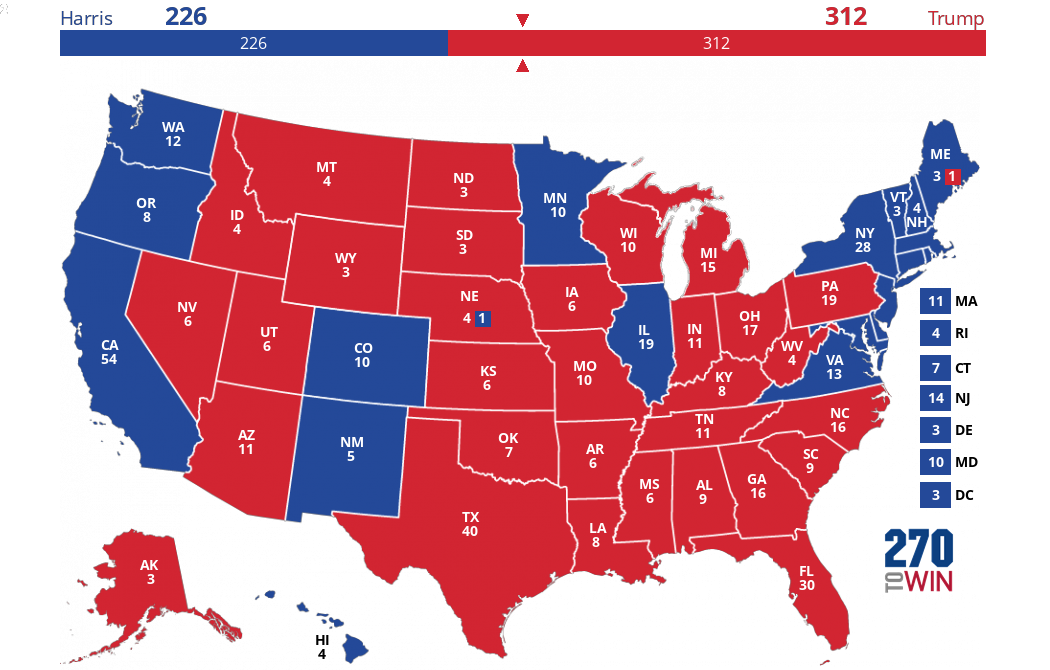Colorado
Colorado gained statehood in August 1876. After voting primarily Republican from 1920-2004, the state has voted with the Democrats in the last five presidential elections, including Kamala Harris's 11% margin in 2004.
In recent decades, Colorado’s population has been growing more quickly than that of the country. This has led to a corresponding increase in electoral votes, from six as recently as 1968 to 10 after the 2020 Census.
ELECTORAL VOTES
10Recent Presidential Elections
| 2024 |
|
|||
| 2020 |
|
|||
| 2016 |
|
|||
| 2012 |
|
|||
| 2008 |
|
|||
| 2004 |
|
|||
| 2000 |
|
Presidential Voting History
State voted with the overall winning candidate
Electoral College Votes
Colored bars represent electoral votes by party. Tap or hover to see names.
U.S. Senate Voting History
| Class† | 1988 | 1990 | 1992 | 1994 | 1996 | 1998 | 2000 | 2002 | 2004 | 2006 | 2008 | 2010 | 2012 | 2014 | 2016 | 2018 | 2020 | 2022 | 2024 |
|---|---|---|---|---|---|---|---|---|---|---|---|---|---|---|---|---|---|---|---|
| 1 | |||||||||||||||||||
| 2 |
R
|
R
|
R
|
D
|
R
|
D
|
|||||||||||||
| 3 |
D
|
R
|
D
|
D
|
D
|
D
|
Data: MIT Election Data and Science Lab / Harvard Dataverse through 2018; 270toWin research. These are general election results for the years listed. Special elections, if any, are excluded.
† There are three classes of Senators; one is up for election every second year. Each state has one Senator in two of the three classes.
U.S. House Voting History
| District | 1988 | 1990 | 1992 | 1994 | 1996 | 1998 | 2000 | 2002 | 2004 | 2006 | 2008 | 2010 | 2012 | 2014 | 2016 | 2018 | 2020 | 2022 | 2024 |
|---|---|---|---|---|---|---|---|---|---|---|---|---|---|---|---|---|---|---|---|
| 1 |
D
|
D
|
D
|
D
|
D
|
D
|
D
|
D
|
D
|
D
|
D
|
D
|
D
|
D
|
D
|
D
|
D
|
D
|
D
|
| 2 |
D
|
D
|
D
|
D
|
D
|
D
|
D
|
D
|
D
|
D
|
D
|
D
|
D
|
D
|
D
|
D
|
D
|
D
|
D
|
| 3 |
D
|
D
|
R
|
R
|
R
|
R
|
R
|
R
|
D
|
D
|
D
|
R
|
R
|
R
|
R
|
R
|
R
|
R
|
R
|
| 4 |
R
|
R
|
R
|
R
|
R
|
R
|
R
|
R
|
R
|
R
|
D
|
R
|
R
|
R
|
R
|
R
|
R
|
R
|
R
|
| 5 |
R
|
R
|
R
|
R
|
R
|
R
|
R
|
R
|
R
|
R
|
R
|
R
|
R
|
R
|
R
|
R
|
R
|
R
|
R
|
| 6 |
R
|
R
|
R
|
R
|
R
|
R
|
R
|
R
|
R
|
R
|
R
|
R
|
R
|
R
|
R
|
D
|
D
|
D
|
D
|
| 7 |
R
|
R
|
D
|
D
|
D
|
D
|
D
|
D
|
D
|
D
|
D
|
D
|
|||||||
| 8 |
D
|
R
|
Data: The Princeton Gerrymandering Project through 2018; 270toWin research. These are general election results for the years listed. Special elections, if any, are excluded.
Vertical lines before 1992, 2002, 2012, and 2022 show Census-related redistricting breakpoints. Geographic borders associated with each district number are likely to have changed.
Governor Voting History
Data: Wikipedia through 2018; 270toWin research. These are general election results for the years listed. Special elections, if any, are excluded.

